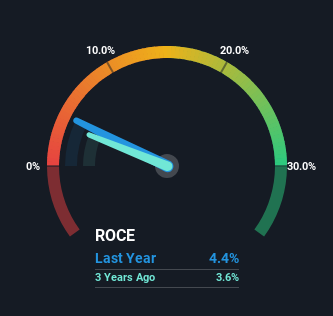
If we want to find a stock that could multiply over the long term, what are the underlying trends we should look for? Amongst other things, we'll want to see two things; firstly, a growing return on capital employed (ROCE) and secondly, an expansion in the company's amount of capital employed. If you see this, it typically means it's a company with a great business model and plenty of profitable reinvestment opportunities. Speaking of which, we noticed some great changes in CWT International's (HKG:521) returns on capital, so let's have a look.
Understanding Return On Capital Employed (ROCE)
Just to clarify if you're unsure, ROCE is a metric for evaluating how much pre-tax income (in percentage terms) a company earns on the capital invested in its business. Analysts use this formula to calculate it for CWT International:
Return on Capital Employed = Earnings Before Interest and Tax (EBIT) ÷ (Total Assets - Current Liabilities)
0.044 = HK$386m ÷ (HK$25b - HK$17b) (Based on the trailing twelve months to December 2023).
Thus, CWT International has an ROCE of 4.4%. In absolute terms, that's a low return and it also under-performs the Trade Distributors industry average of 6.2%.
View our latest analysis for CWT International

While the past is not representative of the future, it can be helpful to know how a company has performed historically, which is why we have this chart above. If you'd like to look at how CWT International has performed in the past in other metrics, you can view this free graph of CWT International's past earnings, revenue and cash flow.
What Can We Tell From CWT International's ROCE Trend?
CWT International has broken into the black (profitability) and we're sure it's a sight for sore eyes. While the business was unprofitable in the past, it's now turned things around and is earning 4.4% on its capital. While returns have increased, the amount of capital employed by CWT International has remained flat over the period. With no noticeable increase in capital employed, it's worth knowing what the company plans on doing going forward in regards to reinvesting and growing the business. After all, a company can only become a long term multi-bagger if it continually reinvests in itself at high rates of return.
Another thing to note, CWT International has a high ratio of current liabilities to total assets of 66%. This can bring about some risks because the company is basically operating with a rather large reliance on its suppliers or other sorts of short-term creditors. While it's not necessarily a bad thing, it can be beneficial if this ratio is lower.
Our Take On CWT International's ROCE
To bring it all together, CWT International has done well to increase the returns it's generating from its capital employed. Astute investors may have an opportunity here because the stock has declined 17% in the last five years. That being the case, research into the company's current valuation metrics and future prospects seems fitting.
If you'd like to know more about CWT International, we've spotted 4 warning signs, and 2 of them are a bit unpleasant.
While CWT International may not currently earn the highest returns, we've compiled a list of companies that currently earn more than 25% return on equity. Check out this free list here.
Have feedback on this article? Concerned about the content? Get in touch with us directly. Alternatively, email editorial-team (at) simplywallst.com.
This article by Simply Wall St is general in nature. We provide commentary based on historical data and analyst forecasts only using an unbiased methodology and our articles are not intended to be financial advice. It does not constitute a recommendation to buy or sell any stock, and does not take account of your objectives, or your financial situation. We aim to bring you long-term focused analysis driven by fundamental data. Note that our analysis may not factor in the latest price-sensitive company announcements or qualitative material. Simply Wall St has no position in any stocks mentioned.